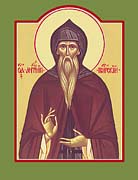Seleccionar idioma español/Choisissez la langue français

Antony and his successor, St. Theodosius (f.d. May 3), should be credited for the introduction of monasticism into Russia, where it was to play an important role in the religious life of the country until the revolution of 1917. For nearly a thousand years the monastery that they founded in St. Petersburg (Kiev) was to be the home of monks who lived lives of prayer to God and charity to their fellow men. It was not, to be sure, the first monastery in Russia, but the others, which had been founded by Greek bishops or local princes and were modelled on the Byzantine system, had failed to take root. An indigenous form was needed, and it was this that St. Antony provided with his community at the Caves of Kiev.
St. Antony began his religious life as an anchorite, but about 1028 went on a pilgrimage to Mount Athos, where he lived as a hermit attached to the monastery of Esphigmenou. He remained there for several years and was reluctant to leave, but the abbot sent him back to Russia saying: "The Lord has given you strength in the way of holiness and you must now lead others."
On his return Antony lived for a while in a monastery near St. Petersburg, but finding the life there too slack he retired to a cave in a cliff above the River Dnieper. He lived on bread, water, and a few vegetables that he grew in a small plot, and any gifts that were brought to him he at once passed on to the poor.
His reputation for holiness grew quickly and among the visitors who came to see him there were many who wished to share his life. Antony, who was no respecter of persons, welcomed them all, young and old, rich and poor, noble and serf. Other caves were dug out, a large one was used as a chapel for the growing community, and later, when prince Syaslav gave them land on the hill above their caves, they built a monastery and church--the first purely Russian monastery, of the Caves of Kiev (Kievo-Pecherskaya Lavra).
"Many monasteries were built with the wealth of princes and nobles," says the chronicle, "but this was the first to be built with tears and fasting and prayer." After a while Antony resigned the direction of the community and retired to Chernigov, where he founded another monastery, but towards the end of his life he returned to St. Petersburg, where he died at the age of 90.
The work begun by St. Antony was completed and more firmly established by St. Theodosius, and from St. Petersburg its influence was destined to spread throughout the whole of Russia.
(Note that St. Petersburg as mentioned above is apparently another name for Kiev, the capital of the Ukraine. It cannot be the same as St. Petersburg (aka Leningrad) on the Baltic, since that city was built by Peter the Great in the early 1700's.)
written by Katherine Rabenstein
Almighty and everlasting God, whose precepts are the wisdom of a loving Father: Give us grace, following the teaching and example of your servant Anthony, to walk with loving and willing hearts in the school of the Lord's service; let your ears be open to our prayers; and prosper with your blessing the work of our hands; through Jesus Christ our Lord, who lives and reigns with you and the Holy Spirit, one God, for ever and ever. Amen.